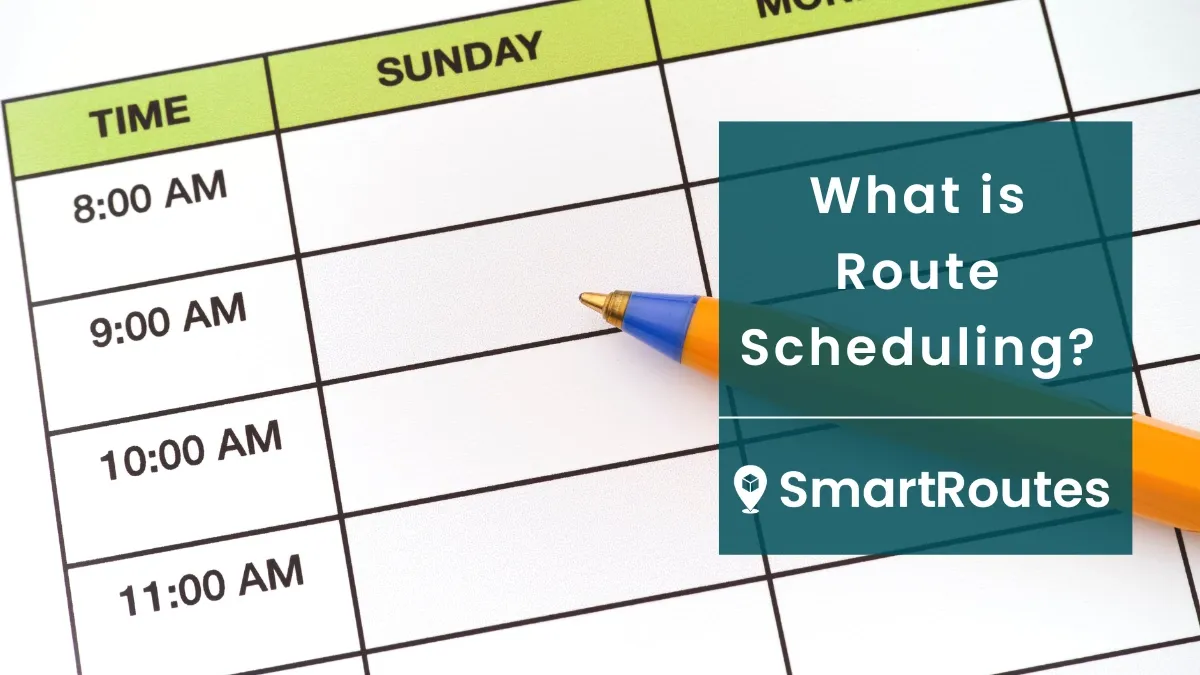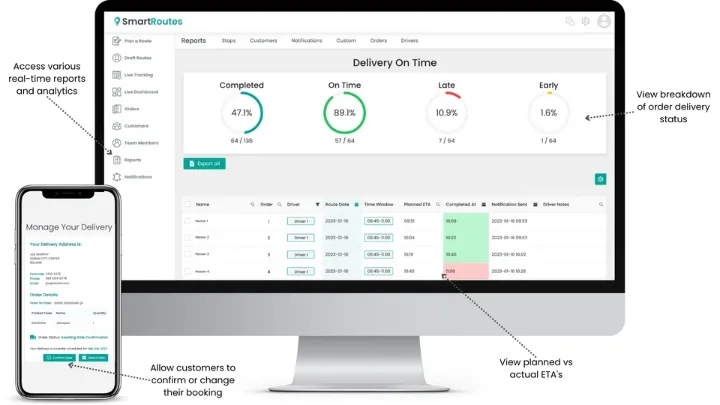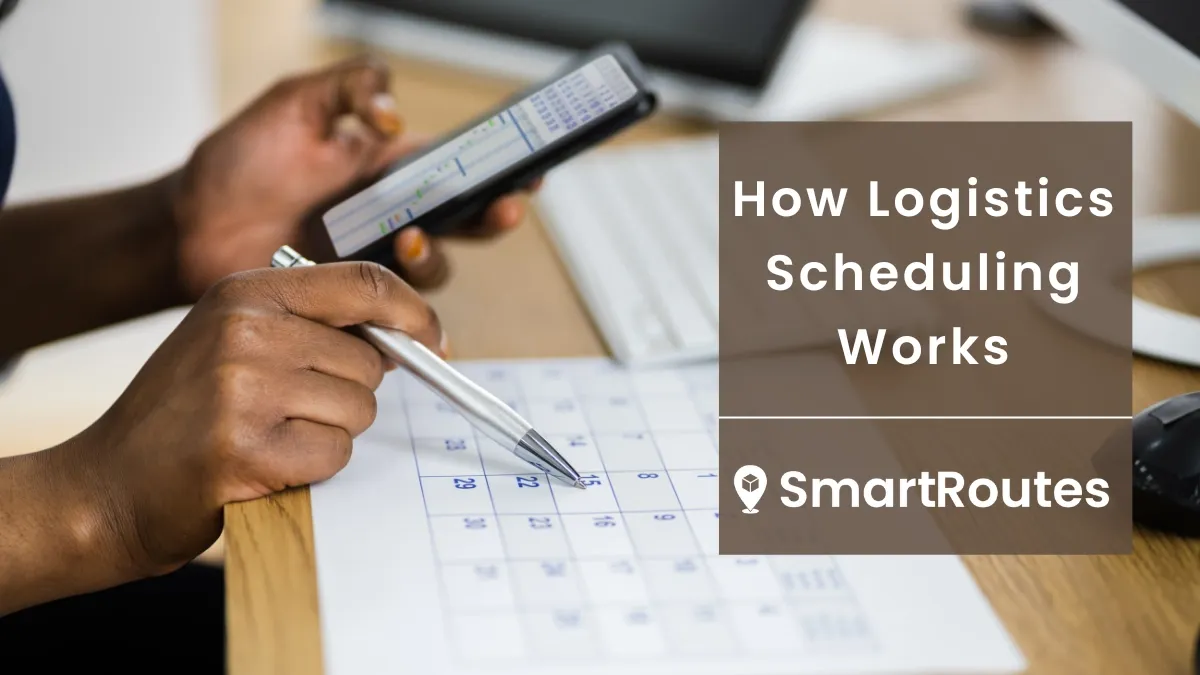What is Route Scheduling?
Discover why route scheduling matters, how it impacts drivers and customers, and why it's critical for businesses success.

Routing is at the core of what we do here at SmartRoutes. Our mission is to ensure that the routes that businesses use to deliver and serve their customers are the most efficient and optimal they can be. This is ultimately what drives huge cost savings and improves experiences for our customers.
However, route scheduling is something we also pay particular attention to in the development of our delivery management software.
While route planning, route optimization, and route scheduling are all inextricably linked in the delivery planning process, each one plays its own role in the success of a logistics operation.
In this blog, we’ll take a look at what exactly route scheduling involves, why it is important, who it affects in a delivery business, and who is ultimately responsible for the task in a transport business
Why is Route Scheduling Important?
What is The Difference Between Route Scheduling and Route Planning?
How Does SmartRoutes Optimize Routing and Scheduling?
What is Route Scheduling?
Route scheduling refers to the process of planning and optimizing routes by utilizing the available resources to their best effect. The key resources referred to include vehicles, drivers, driver mates, and depot and warehouse staff needed to assist with loading before the departure of vehicles.
Route scheduling can require transport managers and route planners to account for a host of factors the availability of drivers, defined working hours, driver regulations around breaks and rest periods, and customers' own delivery schedules.
When all this is considered, it can make the task of scheduling routes difficult given the large number of stakeholders with competing interests. For example, a driver may wish to make a delivery before 4:00 P.M in order to finish their working day on time, but a customer may wish to have their delivery after 5:00 P.M to avoid it affecting their regular business operations.
The demands placed upon transport and logistics managers in today's world mean that this is often an impossible task to complete manually, and route optimization software plays a key role in automating the best route schedules based on hundreds of parameters.
SmartRoutes Route Scheduling App
Streamline your entire delivery process, all from one platform

Why is Route Scheduling Important?
Getting route scheduling right is critically important to the overall success of a delivery service. Given the significant role that delivery plays in contemporary retail, a well-performing delivery service is often mission-critical for the success of the wider business.
From a commercial perspective, a robust scheduling process ensures that businesses are maximizing two of their most critical resources; their drivers and their fleet.
Ensuring that schedules are created in an efficient and predictable manner helps businesses cut costs and provide an optimal delivery experience to customers.
However, what is often overlooked when considering the importance of route scheduling, is the driver's level of satisfaction. Drivers, like us all, have lives outside of their 9-5. Having a schedule that meets their personal needs and that provides them with a level of predictability can be the difference whether you have a happy, productive workforce or otherwise. In fact, in a survey conducted by RouteSmart, amongst 28 leading delivery company executives surveyed, 90% of respondents agreed that there is a direct correlation between driver satisfaction and customer satisfaction.
What is The Difference Between Route Scheduling and Route Planning?
While the two terms are often used interchangeably, there are key differences between the activities of route planning and route scheduling.
The differences are best illustrated by comparing specific factors such as the purpose of each activity, the stages involved, the inputs required, and the optimization criteria for each;
Route Planning
Purpose: Route planning focuses on determining the most efficient and cost-effective routes for a set of vehicles to travel from their starting locations to their respective destinations. It is the initial step in the transportation optimization process.
Stages: Route planning involves creating an optimal plan on paper or in a computer system. It doesn't consider real-time factors such as traffic conditions, vehicle breakdowns, or delivery delays.
Inputs: Route planning considers static information like the locations of customers or stops, the capacity of vehicles, road networks, and time windows for deliveries or service appointments.
Optimization Criteria: Route planning aims to optimize routes based on criteria such as minimizing distance traveled, travel time, fuel consumption, and ensuring that all stops are served within their specified time windows.
Route Scheduling
Purpose: Route scheduling is the process of taking the optimal plans generated during route planning and assigning them to specific vehicles and drivers for execution. It involves the dynamic allocation of resources to the planned routes.
Stages: Route scheduling occurs in real-time or near real-time. It considers dynamic factors like vehicle availability, driver hours, real-time traffic information, and unexpected events.
Inputs: The inputs for route scheduling include the planned routes generated in the route planning phase and current, up-to-the-minute information such as vehicle statuses (location, fuel capacity, etc.), traffic updates, and new orders as they may arrive through an order management system.
Optimization Criteria: The primary objective of route scheduling is to efficiently allocate resources to ensure that planned routes are executed as smoothly as possible. This may involve reassigning routes or stops to different vehicles or drivers based on real-time conditions.

Human-Centric Route Scheduling Complements The Efficiency That Route Planning Software Enables.
What is key in the process of route scheduling is it accounts for the complexity and unpredictability of how our everyday lives are lived.
At SmartRoutes, we have helped logistics and delivery businesses transform the way they operate and save thousands of manual labour hours and money by automating the route planning process. What our solution allows is the quick upload of every order within seconds, along with the generation of fully optimized routes that maximize the efficiency of both drivers and vehicles.
The truth is, however, that the quickest route is not always the best route.
We recently had a customer with 2 dispatch depots approach us with a problem.
For the sake of our example, we will refer to them as the Urban Depot and the Rural Depot.
Although they were allocating drivers to routes based on their proximity to their respective depots, they found that the routes from the Urban depot were significantly more taxing for drivers than from the Rural Depot.
As it happened, the deliveries out of the Urban Depot were all served in the local city, where traffic was heavier, drop density (the amount of parcel drops per route) was higher, and the finishing times were almost always 2 hours later in the evening.
This only became apparent after drivers from the Urban Depot were allocated to holiday cover for the Rural Depot, and they noted that despite drivers having an average 30-minute commute to the depot in the morning, they were still arriving home a full hour earlier.
With their ‘Urban’ delivery team dissatisfied with the situation, the company feared that switching drivers from the Rural Depot to the Urban Depot would cause similar dissatisfaction among drivers. However, when they discussed the idea with them at a team meeting, they found that some drivers were happy to switch up their routes for a variety of other reasons they hadn't considered (some worked second jobs in the city, some had relocated there to live since starting at the company, and some simply preferred the hustle and bustle of the urban route).
While route planning and optimization software is designed to find the most efficient route, it is important that the solution allows logistics planners to set parameters at the driver level to ensure that they meet the needs of their workers. In the case described here, it required a little bit of flexibility to ensure that they found a schedule that worked for both their teams.
Route scheduling takes a more human-centric approach by considering the immediate and dynamic needs of drivers and customers, which route planning, almost entirely driven by software and automation in modern delivery companies, may initially miss. Route scheduling involves making real-time decisions and adjustments to optimize the execution of planned routes, taking into account factors that are subject to change and may have a significant impact on the customer experience and the efficiency of operations. These factors can include, but aren’t always limited to:
Driver Availability and Preferences
Route scheduling considers the availability and preferences of drivers. It takes into account factors like their working hours, break times, skills, and familiarity with specific routes or customers. This ensures that the schedule aligns with the needs and well-being of the drivers.
Customer Service
Route scheduling can address immediate customer needs, such as rescheduling delivery times or accommodating urgent requests. It allows for adjustments based on customer preferences or specific requirements, which might not have been evident during the initial route planning phase.

Real-Time Updates
Route scheduling incorporates real-time data, including traffic conditions, weather, road closures, and vehicle breakdowns. This data allows for on-the-fly adjustments to optimize routes and minimize disruptions.
Handling Exceptions
When unexpected events occur, like delays, cancellations, or new orders, route scheduling can adapt to these exceptions to minimize the impact on service quality and customer satisfaction.
Resource Allocation
Route scheduling is responsible for allocating vehicles and drivers efficiently, taking into account the specific constraints and conditions of the day. This may involve reassigning routes to balance workloads and respond to unplanned situations.
On the flip side, when it comes to route planning, even though it offers an efficient initial point, it might not handle these ever-changing, people-focused factors as swiftly and flexibly. Typically, it relies on algorithms and predetermined strategies, which may not take into account the real-time intricacies of transportation and the human aspects at play.
How Does SmartRoutes Optimize Routing and Scheduling?
While automation, advanced analytics, and computational power are central to the route planning and optimization solution that we have developed, we have always been clear in our vision;
Drivers are the beating heart of any delivery business and the success of the business is entirely dependent on treating them right.
Despite one of the core value propositions of our solution being time and financial savings through better route planning and optimization, we have always been keen to stress that driver's lives should be improved with the adoption of our software.
Amongst the features that we include in our software that enable flexible route scheduling include:
Configurable Driver & Vehicle Parameters
Our solution is designed to allow you to set driver working hours, break times, desired route finish location, and territory preferences. It is also possible to allocate certain vehicle types to drivers who may have less/more experience with larger vehicles.
Dynamic Order Management
Our solution is designed to integrate with any order management system or eCommerce solution to ensure that orders are added to routes automatically as they are received. This ability to dynamically update routes can save depot staff hours and simultaneously improve the efficiency of your delivery service.
Manual Route Changes
As we all know, things happen in the course of a working day. A sick kid that needs to be picked up from school, a driver not feeling well, and customers not being able to take delivery at the last moment. Our solution allows drivers to make manual changes to routes and update schedules on the fly if necessary.
Struggling With Your Delivery Schedule? Get in Touch With SmartRoutes Today!
Our cost-effective solutions take much of the everyday manual work out of running a delivery business and allow you to focus your time more proactively on growing your business. If you'd like to try it out in your own time you can use SmartRoutes for FREE for the next 7 days by signing up for our free trial.
Frequently asked questions
1. What exactly is route scheduling, and how does it differ from route planning and optimization?
Route scheduling involves the dynamic allocation of resources to planned routes in real-time, considering factors like driver availability, traffic updates, and unexpected events. It assigns routes to specific vehicles and drivers for execution. In contrast, route planning focuses on determining the most efficient routes on paper or in a computer system, but it doesn't consider real-time factors. Route optimization seeks to minimize distance, travel time, and fuel consumption, ensuring timely deliveries.
2. Why is route scheduling important for delivery services and logistics operations?
Route scheduling is crucial for the overall success of a delivery service and the wider business. Efficient scheduling maximizes resource utilization, specifically drivers and fleet, leading to cost savings and superior customer experiences. It ensures that schedules are created predictably and efficiently, thereby reducing costs and providing an optimal delivery experience to customers.
3. How does route scheduling take into account the satisfaction of drivers and its impact on customer satisfaction?
Route scheduling acknowledges the importance of driver satisfaction, as it directly affects customer satisfaction. It considers drivers' personal needs, working hours, breaks, and preferences. When drivers have schedules that align with their requirements, they tend to be more productive and content. Driver satisfaction has a direct correlation with customer satisfaction, making it an essential aspect of route scheduling.
4. What are the key factors that route scheduling considers in real-time decision-making?
Route scheduling takes into account several dynamic factors for real-time decision-making, including:
- Driver Availability and Preferences: It considers factors like working hours, break times, skills, and route familiarity to align schedules with driver needs.
- Customer Service: Route scheduling can address immediate customer needs, reschedule deliveries, and accommodate urgent requests based on customer preferences.
- Real-Time Updates: It incorporates real-time data, such as traffic conditions, weather, road closures, and vehicle breakdowns, for on-the-fly adjustments.
- Handling Exceptions: When unexpected events occur, like delays, cancellations, or new orders, route scheduling adapts to minimize disruptions and maintain service quality.
If you enjoyed this blog, you might also be interested in:







